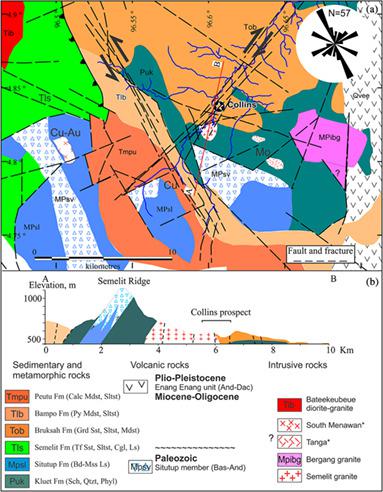Initial exploration results of the Collins epithermal Au‐base metal prospect, Aceh, Indonesia
IF 0.8
4区 地球科学
Q3 GEOLOGY
引用次数: 1
Abstract
Interpretation of various exploration data, in particular geochemical prospecting, offers a powerful and rapid assessment of grass‐root projects in a green‐field terrain. Here, we present an example of the Collins epithermal prospect in Aceh Province, Indonesia. In this area, the Au+ base‐metal‐bearing sheeted quartz veins (individually mostly 2–4 cm wide), which are controlled by a 250 m wide by 800 m long NNE‐trending structural corridor within Paleogene sandstone and volcanic rocks, are the product of two main stages of deposition. Stage I formed veins with a sliver of cryptocrystalline quartz wall zone followed by an inner zone of comb quartz with interstitial rhombic adularia that terminates in open space. Stage I or main‐stage sulfide mineralization consisting of early galena + sphalerite and later chalcopyrite occurs with the quartz + adularia. Small amounts of galena also occur in the wall zone. Stage II mineralization brecciated Stage I veins and overprinted them with silicification characterized by vuggy texture. Mineralization associated with this episode consists of earlier chalcopyrite + sphalerite + tennantite–tetrahedrite and later, vug‐filling Au–Ag alloy (Ag0.37–0.41Au0.62–0.59). The above mineralized veins are successively flanked by silicic selvages, an illite + chlorite + pyrite ± kaolinite zone and a chlorite + epidote + carbonate + pyrite zone. Local supergene alteration induced replacement of galena by plumbogummite and anglesite and chalcopyrite by covellite. Data from fluid inclusion microthermometry in quartz indicated that the inner zone of Stage I veins formed from fluids with a 2.3 wt% salinity (0.5–3.3 wt% NaCl equivalent), at 174°C (155–211°C). Combining these physico‐chemical parameters with the mineral assemblage, the mineralization occurred under a reduced environment. Rock and soil assays indicate that elevated Au concentrations (up to 16.5 ppm over 1 m) occur along northeast‐trending zones and show a strong correlation with Pb, while Cu (up to 2.58% over 1 m), Zn, As, Sb, and Mo anomalies lie mostly at the periphery. The high‐grade mineralized veins correlate with moderate to high resistivity and chargeability zones, and the pseudosections of such geophysical signals are interpreted as reflecting coalesced or enlarged veins at depth, or inclined veins in other localities. The intermediate sulfidation affinity for Collins points to potential mineralization at depth as well as preservation of Au‐rich and sulfide‐poor zones in the less eroded areas.

印度尼西亚亚齐Collins浅成热液金母金属远景区的初步勘探结果
各种勘探数据的解释,特别是地球化学勘探,为绿地地形的基层项目提供了强大而快速的评估。在这里,我们介绍了印度尼西亚亚齐省柯林斯浅成热液远景的一个例子。在该地区,受一条宽250 m、长800 m的北北东向构造走廊控制的含金母金属片状石英脉(单条宽2 ~ 4 cm)是两个主要沉积阶段的产物。第1阶段形成脉,其壁带为带状隐晶石英,内带为梳状石英,内有间质菱形柱头,止于开阔空间。第一阶段或主阶段硫化物矿化由早期方铅矿+闪锌矿和晚期黄铜矿组成,与石英+黄铜矿共生。少量方铅矿也出现在岩壁区。第二期矿化将第一期矿脉角化,并覆以溶洞状结构的硅化作用。与此期相关的矿化由早期的黄铜矿+闪锌矿+ tennantite-tetrahedrite组成,后期为充填孔洞的Au-Ag合金(Ag0.37-0.41Au0.62-0.59)。上述矿化脉体两侧依次为硅质带、伊利石+绿泥石+黄铁矿±高岭石带和绿泥石+绿帘石+碳酸盐+黄铁矿带。局部表生蚀变导致方铅矿被铅铅矿取代,角菱石和黄铜矿被钴石取代。石英流体包裹体显微测温数据表明,ⅰ期矿脉内带由盐度为2.3 wt%(相当于0.5 ~ 3.3 wt% NaCl)的流体形成,温度为174℃(155 ~ 211℃)。将这些物理化学参数与矿物组合相结合,表明成矿发生在还原环境下。岩石和土壤分析表明,沿东北向带出现Au浓度升高(1 m内高达16.5 ppm),与Pb有很强的相关性,而Cu (1 m内高达2.58%)、Zn、As、Sb和Mo异常主要位于外围。高品位矿化矿脉与中、高电阻率和电荷率带相关,这些地球物理信号的伪剖面被解释为反映深部合并或扩大的矿脉,或其他位置的倾斜矿脉。Collins的中间硫化物亲和性指出了深部潜在的矿化,以及在侵蚀较少的地区保存了富金矿和贫硫化物带。
本文章由计算机程序翻译,如有差异,请以英文原文为准。
求助全文
约1分钟内获得全文
求助全文
来源期刊

Resource Geology
地学-地质学
CiteScore
2.30
自引率
14.30%
发文量
18
审稿时长
12 months
期刊介绍:
Resource Geology is an international journal focusing on economic geology, geochemistry and environmental geology. Its purpose is to contribute to the promotion of earth sciences related to metallic and non-metallic mineral deposits mainly in Asia, Oceania and the Circum-Pacific region, although other parts of the world are also considered.
Launched in 1998 by the Society for Resource Geology, the journal is published quarterly in English, making it more accessible to the international geological community. The journal publishes high quality papers of interest to those engaged in research and exploration of mineral deposits.
 求助内容:
求助内容: 应助结果提醒方式:
应助结果提醒方式:


